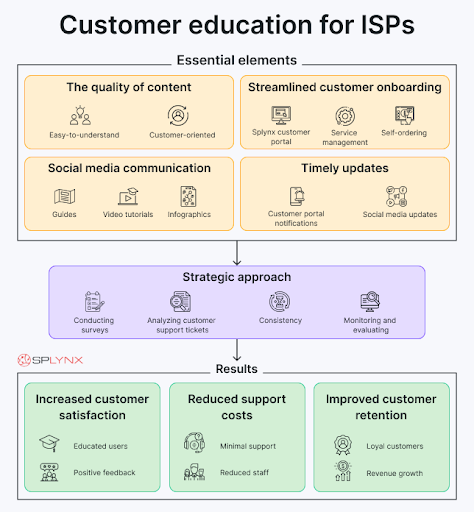



Many users encounter difficulties with their home networks, commonly called the last nine yards. However, when individuals or small businesses sign up for internet connectivity, they often fail to realize that sorting out device or home network-related issues is not included in the package. This highlights a lack of educational resources available to them.
While customers expect to receive support in setting up their devices and networks, the service provider is not responsible for addressing all technical difficulties that may arise. Instead, it provides the basic infrastructure necessary for connectivity. This gap in knowledge and education can lead to frustration and confusion for users who lack the technical skills to troubleshoot problems independently.

Customer education gives customers the knowledge and skills they need to understand and use a product or service effectively. In the context of internet service providers, customer education can be particularly beneficial for both the provider and the customer. One example of customer education that an ISP may offer is a comprehensive guide on setting up a home network, including instructions for troubleshooting common issues such as slow internet speeds or connectivity issues.
By providing this type of education, ISPs can help their customers understand better how to use their internet service, resulting in improved customer satisfaction. Regarding support services, customers generally grasp the geographical support radius, but they may need further context to understand the limitations fully. For example, a customer may understand that fast food delivery is only available within a 5 km radius. Yet, they may still expect a support technician to travel much further without charging extra fees.
Although this expectation is unrealistic, with clear communication and context, customers can grasp the expectations and be willing to fix common issues with the educational content their ISP provides. Additionally, by empowering customers to troubleshoot issues independently, support costs can be drastically reduced for the ISP.
Another example of customer education that ISPs can provide is information about internet security and privacy. Many users are unaware of the internet’s risks and may inadvertently expose themselves to online threats. By educating customers on best practices for securing their network and protecting their personal information, ISPs can help build stronger relationships with their customers and improve overall customer satisfaction.

To deliver an effective customer education program, there are five essential elements that ISPs must incorporate. These elements help ensure that customers have a clear understanding of the service and feel confident in their ability to use it.
1. The quality of content: The first step to creating customer-oriented content is to identify the common issues your customers face. This can be achieved by analyzing customer support tickets or conducting surveys. Once you have a list of problems, you can create content that provides solutions or educates customers on how to solve the issues themselves.
Another way to create valuable content is by developing a knowledge base. This resource can include articles, videos, and infographics that provide step-by-step instructions on how to use your services or troubleshoot common problems. By doing so, you can reduce the number of support tickets your team receives and improve customer satisfaction.
2. Social media communication: Social media is also a powerful tool for distributing content. By sharing informative infographics or answering customer questions in real time, you can demonstrate your commitment to customer satisfaction and build a loyal following. The topics for the customer education strategy should be easy-to-understand and create a meaningful connection. From those who are just starting to use your service to those who are experienced super-users, all of your customers require useful and relevant content. This allows you to deliver valuable learning opportunities to all users, regardless of their level of expertise with your service.
For example, a great strategy for customer centric ISPs is to provide video tutorials on their YouTube channel or infographics in social media that cover topics such as setting up Wi-Fi, troubleshooting slow internet speeds, and managing parental controls.
3. Streamlined customer onboarding process: The onboarding process should be designed to make it as easy as possible for customers to get started with your service and to quickly understand how to use it. The new Splynx customer portal is a useful tool for simplifying the onboarding process. Designed to be mobile-friendly with easy-to-navigate blocks, it provides customers with a clear overview of their account, including their service plan, billing information, and any devices connected to the network. This helps customers understand what they are paying for and how to access, pause or order a new service, which in turn enhances self-service management.
Additionally, all new customers receive a quick step-by-step guide around the main blocks of the Splynx portal, which help them get started quickly and reduce the need for support tickets. You can also read an article on our website to learn more about how to streamline customer onboarding in Splynx.
4. Self-service capabilities: With Splynx TR-069 ACS, ISPs gain a powerful tool to educate their subscribers on managing their accounts effectively. This includes providing customers with the ability to update essential settings such as their Wi-Fi SSID and password directly from their portal accounts. Customers no longer need to rely on manual interactions with the ISP’s support department or sending support tickets for simple account updates. Instead, they have the freedom to make these changes on their own, instantly and effortlessly. This hands-on approach not only enhances customers’ technical skills but also cultivates a stronger understanding of their internet services. As a result, subscribers become more self-reliant, reducing their dependence on support resources for basic account management tasks.
5. Timely updates: It is crucial for ISPs to keep their customers informed of any changes to their service or technology. This includes updates to software, security features, and new service offerings. Timely updates can help customers stay informed and reduce confusion and frustration. This can be done through customer portal news/notifications or social media updates. For example, ISP s can notify their customers about new services available in their area through the Splynx customer portal.
6. Strategic approach: As an ISP owner, it’s crucial to understand that creating content isn’t just another item on your to-do list. Rather, it should be considered as a strategic function that serves a larger purpose in your business. The content you create can help educate your customers about your services, and in turn, scale your business and outstand the competition.
By incorporating these elements, ISPs can deliver a customer education program that meets the needs of their customers and ensures their success.
To ensure that an ISP business is delivering an effective customer education program, it’s important to evaluate its success. This evaluation can help identify areas of improvement and make necessary adjustments to the program.
1. Customer satisfaction: Measure customer satisfaction through surveys, feedback forms, and online reviews. If customers are satisfied with the service and feel confident in their ability to use it, this is a good indication that your customer education program is working.
2. Support costs: Evaluate your support costs to determine if your customer education program is reducing support requests. If customers are able to resolve issues on their own or with minimal support, this is a good indication that your program is effective.
3. Customer retention: Evaluate your customer retention rates to determine if your customer education program is building strong customer relationships. If customers are staying with your service for an extended period, this is a good indication that they are satisfied with the service and feel confident in their ability to use it.
By evaluating the success of their program, ISPs can ensure that their customers have a clear understanding of the service and feel confident in their ability to use it, ultimately resulting in a stronger customer relationship and increased business success.
In conclusion, customer education is crucial for ISPs to provide their customers with the knowledge and skills to use their products and services effectively. Ultimately, providing effective customer education is a win-win situation for both the ISP and the customer, leading to a stronger relationship and better outcomes for both parties.
P.S. If you want to find out how allowing customers to manage their own plans via Splynx Customer Portal resulted in additional revenue for AU Wireless, read their full success story on our website: https://splynx.com/success-stories/au-wireless/.
Find out how Splynx helps ISPs grow
Learn more